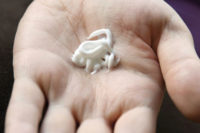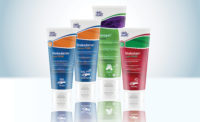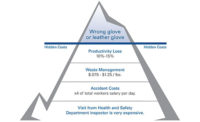When it comes to work-related health problems, many people might think about back issues, respiratory issues or hearing loss. Actually, skin disorders are one of the most common forms of occupational disorders in the United States. Working skin is exposed to a multitude of harmful chemical, physical and mechanical hazards, and it is vital to take effective measures to protect skin when it is likely to come into contact with cooling lubricants, grease, oil, acids and caustic solutions, detergents, cleaning agents, solvents, metallic dust and UV radiation.
All these low-grade hazards do not lead to an instant acute skin irritation, but regular skin contact with them in non-acute toxic concentrations may lead to an irritant contact dermatitis (ICD). Dry and chapped skin is the first indication of a looming skin disorder.
Occupational Skin Disorders (OSD) can easily be averted at this early stage by protective measures and by paying more attention to the skin. Sustained pressures on the skin’s own regenerative capabilities, however, may result in development of serious skin disorders.
Published literature shows that one out of 1,000 workers will report a work-related skin disorder per year in Western industrialized countries. But this is only the tip of the iceberg. Many workers do not report work related skin problems; often because they do not see that their skin issues are work related. Some even think cracked and irritated skin is proof of being a hard worker. Others prefer not to mention the issues because they are afraid of possible repercussions from their employer. It is estimated that the number of unreported work related skin issues is 50 to 70 times higher than the reported cases.
Doing the math
It can be concluded that 1 out of 20 workers will experience work-related skin issues. Those can be minor (thus the potential beginning of a serious dermatitis) or already significant.
Skin diseases have both economic effects and mental and social effects for the affected. People look at our hands. And who would like to shake a hand with broken or inflamed skin? Skin problems have a major impact on our wellbeing. Skin disorders, if they get worse, can even force people to give up their job.
There are only a few studies focusing on the real costs of work-related skin problems. One study analyzed data from the state of Oregon collected in the years 1990–97. The authors came up with costs of $3,552 per case.
But some of the costs related to work-related skin problems can hardly be evaluated. Examples are the impact of lost motivation and production loss. The numbers can be much higher for workers in higher salary grades, too. Data from other countries actually estimate the costs of work related skin problems to be significantly higher than evaluated in this study. So, it can be concluded that these $3,552 per case reflect the lower end of costs for work related dermatitis.
In total the costs for work-related skin problems are estimated to exceed $1 billion per year in the United States alone. (US Centers for Disease Control and Prevention)
Any effort to prevent work related health issues, including skin disorders, should follow the STOP principle:
S — Substitution
First and foremost are measures to eliminate hazardous workplace substances that may irritate the skin or cause skin problems by replacing with more skin friendly substances.
T — Technology
Technical measures to avoid skin contact to skin irritants like capsuling machinery to avoid splashes on the skin.
O — Organization
Introduce changes in the work flow. These may include rotating personnel to avoid longer and intense skin exposure in individuals. Or changing work procedures allowing longer drying time before parts need to be touched.
P — PPE
The last step is using Personal Protective Equipment (PPE) to reduce skin contact. In the case of hands, it’s usually gloves that are used to prevent skin contact.
Pre-work precautions
An occupational skin-care program will complete measures taken using the STOP principle.
Such a program will consist of three or four steps depending on the particular work situation: Pre-work products, mild hand cleanser, hand sanitizers if required, and restore products.
Pre-work products will help to support the skin‘s natural barrier and reduce contact to workplace substances and contaminants, helping to keep the skin healthy and make skin easier to clean. It is important to select products that are specific to the particular work situation.
Pre-work products are never intended to replace primary PPE. They support the skin’s natural barrier against workplace substances or environmental effects on the skin at the workplace. Investigations demonstrate that a reliable protection against percutaneous absorption of systemically toxic substances is not to be expected. Therefore the term ‘invisible glove’ is incorrect relating to pre-work products and gives users a false sense of safety. Complete protection against any workplace substances cannot be provided by any pre-work product.
Occupational skin care: the four steps
1. Protect: Pre-work skin protection creams help protect the skin against contact with various workplace contaminants, irritants and working conditions.
2. Cleanse: Mild cleansers adapted to the type and degree of soiling to avoid additional stress to the skin by hand cleansing.
3. Sanitize (where necessary/appropriate): Hand sanitizer that can be used without water to kill germs and provide a higher level of hand hygiene.
4. Restore: After-work skin restore creams help to maintain the skin in healthy condition by keeping the skin soft and supple, avoiding dryness.
Aggressive hand cleansing with industrial solvents, hand brushes or harsh hand cleansers itself can cause skin problems. It is important to select the mildest cleanser possible for the job. Do not use cleansers with pumice scrubbing agent or kerosene or petroleum distillates. These products will irritate skin in addition to the exposure to work conditions.
Some work situations—such as food handling and manufacturing, in health-care settings or in waste and waste water treatment—may require the use of a hand sanitizer. Make sure that the product does include moisturizers to prevent dry skin.
The last step that is unfortunately often neglected is applying a professional restoring skin-care product after work. These special products will help to restore moisture levels in the skin and help the skin to restore its natural barrier function.
Not a replacement for gloves
It is important to stress that an occupational skin-care program and pre-work creams especially are not a replacement for prescribed measures.
They will complement the use of gloves but will not replace it. The use of appropriate and intact gloves is especially important when handling harmful, toxic, corrosive or allergy causing substances as well when being (potentially) exposed to blood and infectious material.
The scientific discussion still continues if or if not the wearing of gloves can cause skin problems itself. Recently, a study involving employees of a semiconductor production company was published in the British Journal of Dermatology. The result of the study was there was no significant difference in skin condition between glove and non-glove wearers. But there was no additional skin stress to wearing gloves. Other studies indicate that glove wearing will contribute to skin problems when other skin stressing factors like frequent hand washing or contact to irritant workplace substances are involved.
Gloves still remain an important measure in preventing exposure to hazardous substances. But gloves should not be worn longer than necessary and should be avoided if there is not really an indication for wearing gloves. The use of a special pre-work cream can help to reduce the negative effects of wearing gloves. This pre-work cream will make wearing gloves more convenient and will help to keep the skin in natural condition. When using an under-glove cream, make sure that the product selected is compatible with the glove material used. Some cream components may degrade the glove material and make the glove ineffective.
In general, fragrance-free products should be preferred over variants with perfume. Fragrance components are known to be able to cause allergy, and there is hardly a benefit of using a scented product in the workplace. Wash the hands with a very mild skin cleanser after taking the gloves off, even if you use an under the glove cream. And do not forget to apply a restoring skin care product after work.
Program prevents skin problems
Studies have proven that an occupational skin-care program helps to prevent skin problems. One study compared groups with different product use habits. One group only used pre-work products, another only restore-products and another group both, pre-work and restore products in addition to hand cleanser. After 12 months, 27 percent of the workers using after-work restore creams showed improved skin conditions. The use of a pre-work cream alone was a little more effective with 31 percent improvement. But best results were achieved when using both pre-work and after-work restore products.
In another study with employees from an Austrian oil and gas exploration company, it was possible within eight weeks to reduce the incidence of skin problems from 55 percent to less than 20 percent by occupational skin-care measures. It is important to stress that a successful skin-care program does not only consist of products. Training of the workers and create awareness are important elements too.
But what does it cost to implement an occupational skin care program? Under normal conditions, a worker will use one liter pre-work and one liter restore cream per year in addition to the cleansers already provided. The costs for these two products will be around $50 per year and worker. This little investment will help save thousands of dollars for occupational skin disorders.



